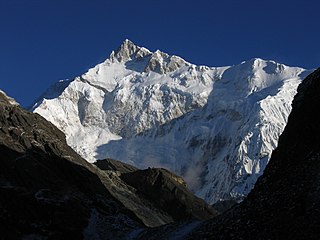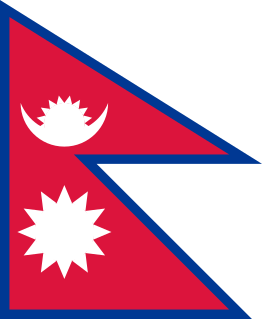
An abjad is a type of writing system where each symbol or glyph stands for a consonant, leaving the reader to supply the appropriate vowel. So-called impure abjads do represent vowels, either with optional diacritics, a limited number of distinct vowel glyphs, or both. The name abjad is based on the old Arabic alphabet's first four letters—a, b, j, d—to replace the common terms "consonantary" or "consonantal alphabet" to refer to the family of scripts called West Semitic.

Sinhala script is a writing system used by the Sinhalese people and most Sri Lankans in Sri Lanka and elsewhere to write the Sinhala language, as well as the liturgical languages Pali and Sanskrit. The Sinhalese Akṣara Mālāva, one of the Brahmic scripts, is a descendant of the ancient Indian Brahmi script and closely related to the South Indian Grantha script and Kadamba alphabet.
The Thai script is the abugida used to write Thai, Southern Thai and many other languages spoken in Thailand. The Thai alphabet itself has 44 consonant symbols, 15 vowel symbols that combine into at least 28 vowel forms and four tone diacritics to create characters mostly representing syllables.
The Burmese alphabet is an abugida used for writing Burmese. It is ultimately a Brahmic script adapted from either the Kadamba or Pallava alphabet of South India, and more immediately an adaptation of Old Mon or Pyu script. The Burmese alphabet is also used for the liturgical languages of Pali and Sanskrit.
The Balinese script, natively known as Aksara Bali and Hanacaraka, is an alphabet used in the island of Bali, Indonesia, commonly for writing the Austronesian Balinese language, Old Javanese, and the liturgical language Sanskrit. With some modifications, the script is also used to write the Sasak language, used in the neighboring island of Lombok. The script is a descendant of the Brahmi script, and so has many similarities with the modern scripts of South and Southeast Asia. The Balinese script, along with the Javanese script, is considered the most elaborate and ornate among Brahmic scripts of Southeast Asia.
The Batak script, natively known as surat Batak, surat na sampulu sia, or si-sia-sia, is a writing system used to write the Austronesian Batak languages spoken by several million people on the Indonesian island of Sumatra. The script may be derived from the Kawi and Pallava script, ultimately derived from the Brahmi script of India, or from the hypothetical Proto-Sumatran script influenced by Pallava.

The Khmer script is an abugida (alphasyllabary) script used to write the Khmer language. It is also used to write Pali in the Buddhist liturgy of Cambodia and Thailand.

The Odia script is a Brahmic script used to write the Odia language.

Buhid is a Brahmic suyat script of the Philippines, closely related to Baybayin and Hanunó'o, and is used today by the Mangyans, found mainly on island of Mindoro, to write their language, Buhid.

Tagbanwa, also known as Apurahuano, is one of the suyat writing systems of the Philippines used by the Tagbanwa people as their ethnic writing system and script.

Canadian Aboriginal syllabic writing, or simply syllabics, is a family of abugidas used to write a number of indigenous Canadian languages of the Algonquian, Inuit, and (formerly) Athabaskan language families. They are valued for their distinctiveness from the Latin script of the dominant languages and for the ease with which literacy can be achieved; indeed, by the late 19th century the Cree had achieved what may have been one of the highest rates of literacy in the world.

The Cham script is an abugida used to write Cham, an Austronesian language spoken by some 230,000 Chams in Vietnam and Cambodia. It is written horizontally left to right, as in English.

The Tai Le script, or Dehong Dai script, is a script used to write the Tai Nüa language of south-central Yunnan, China. It is written in horizontal lines from left to right, with spaces only between clauses and sentences.
Warang Citi is an abugida invented by Lako Bodra, used in primary and adult education and in various publications. It is used to write Ho, a language used in the Indian states of Jharkhand, Odisha, West Bengal, Bihar, Chhattisgarh and Assam.

The Lepcha script, or Róng script, is an abugida used by the Lepcha people to write the Lepcha language. Unusually for an abugida, syllable-final consonants are written as diacritics.
In orthography, a zero consonant, silent initial, or null-onset letter is a consonant letter that does not correspond to a consonant sound, but is required when a word or syllable starts with a vowel. Some abjads, abugidas, and alphabets have zero consonants, generally because they have an orthographic rule that all syllables must begin with a consonant letter, whereas the language they transcribe allows syllables to start with a vowel. In a few cases, such as Pahawh Hmong below, the lack of a consonant letter represents a specific consonant sound, so the lack of a consonant sound requires a distinct letter to disambiguate.

The Bamum scripts are an evolutionary series of six scripts created for the Bamum language by King Njoya of Cameroon at the turn of the 19th century. They are notable for evolving from a pictographic system to a partially alphabetic syllabic script in the space of 14 years, from 1896 to 1910. Bamum type was cast in 1918, but the script fell into disuse around 1931. A project began around 2007 to revive the Bamum script.
















